Systems of internal cold and hot water supply. Pump stations for the home: how to ensure a stable head of water
Residents apartment buildings often complain about the strong, discomforting noise from the pump in the basement. In order to effectively eliminate this problem, one must understand that an unpleasant sound does not arise just for that, and it is important to find the cause of its appearance. Only after it is found, the question can be solved.
As a rule, the causes of noise are water supply pumps, which in the usual house are numerous ( central heating, cold and hot water supply).
Pumps in the mode of operation can be divided into two types:
- which work constantly (water supply pumps);
- which are included systematically (pumps pumping, drainage, etc.).
If the pumps are located in free-standing buildings (as was the case in the 1970s), then residents of the house will not hear any noise. However, when placing pumping equipment in the basement, the buzz can be felt quite strongly. It negatively affects the nervous system and the general well-being of people living in the house.
The impact of technical noise on health
Houses that were built before the middle of the last century, have not very good sound insulation characteristics. In other words, everything that happens in the basement is heard in the apartments. Previously, there simply was not any regulations in which the indicators of permissible noise would be prescribed. Today, the issue of the comfort of living in homes is quite acute, so the government introduces special rules, according to which the same noise from the pump should not exceed the established figures.
Most of the complaints come, naturally, from the inhabitants of the first floors, who feel all the "delights" of staying near the source of sound. In itself, noise does not affect the physical health of a person, however, it causes significant psychological stress, which ultimately affects the general state of the body. People become more irritated, chronic fatigue begins to appear. Constant pressure depletes the central nervous system. Some doctors note that psychological anxiety can become one of the causes of internal diseases.
It is also worth noting that, due to noise vibration, communications at home may suffer.

Measurement of noise in the basement.
At the first occurrence of sound vibrations it is necessary to contact specialists or management company.
How does the sound of the basement reach the apartment?
Constant complaints of residents of apartment buildings forced specialists to study the causes of noise from pumping equipment in basements. Based on the results of numerous examinations, it was found that the sound level to a lesser extent depends on the power and variety of the pump, as well as on the manufacturer. Special impact is not rendered and the size of the equipment, because a serious hum can produce even a very small pump.
It was determined that the sound in living quarters from the basement comes in several ways: through the air, structurally and through water through the water pipe:
- If the noise is audible in the street, it means that it is transmitted through the air. The main reason for its appearance is a poor-quality soundproof layer in the room where the pumps are located. The residents of the first floors suffer the hardest of all, the technical rooms are located directly under the apartments. Also noise in apartments is often amplified after their illegal redevelopment.
- Structural noise propagates through the structure of the building. This can occur for various reasons: illiterate installation of pumps, contact of pipes with the walls of the house, the presence of acoustic bridges (metal elements, racks, etc.), the absence of sleeves (they should be installed in the places of passage of pipes through the structure). Specialists note that when eliminating metal bridges, the sound level is reduced by 5-6 dB.
- The noise that is transmitted from the pump in the basement along the water often results from the formation of vortices inside the pump equipment housing. In addition, the promotion of sound will be the absence of special shock absorbers.
The causes of noise can be very different. They can be understood only by specialists. If you are constantly worried about sounds coming from the basement of the house, you should immediately contact the Housing department or another managing body. Experts coming by your application should conduct an assessment of the causes of noise, as well as perform work on its complete elimination (within the limits of the current standards for apartment buildings).
When the source of sounds is the heating system
Often an unpleasant rumble arises in the case of poor design or installation of hydraulic systems, as well as in the unlawful modification of standardized designs of operating pipelines in the house. There are cases when, after unauthorized redevelopment and replacement heating system in the apartment, the installation of warm floors or new plumbing there is a strong noise in the whole house. Often the reason is that after the repair, pipes of larger diameter were installed than required by the design standards. In this case, there is a vibration, which leads to the formation of noise.
Noise may also appear due to the replacement of old pumping systems with new ones. This is because the technical characteristics of the installed equipment do not correspond to the characteristics of the hydraulic system operating in the house. In addition, a small hum can also appear because the damper of the hydraulic system is loosely closed, due to which there is additional resistance and an increase in the speed of water flow through the pipes.
The abnormal movement of water through the pipes (faster or slower), as well as the incorrect diameter of the recently installed pipes, very often become the cause of the appearance of a powerful buzz, which can be eliminated only by installing a new pipeline. That's why before any repair work related to the replacement of water supply and pumping equipment, it is necessary to consult with specialists.
Pump problems creating hum
Noise in pumps can occur for a variety of reasons. This may be incorrect installation of equipment or failure of some elements. The basic sources of noise in pumps are considered to be the engine air cooling system and rolling bearings. These potential sources of noise are inextricably linked to the power of the pump motor and the speed of rotation. Here it is worth mentioning the international ISO standards, according to which the noise produced by the pumping equipment is limited depending on the two above factors.
![]()
Pumping equipment located in the basement.
It is interesting that an increase in acoustic pressure, for example, by 6 dB, based on the real sensations of a person, will be equal to an increase in noise by a factor of two. The sound produced by the pumping system is tightly connected to the speed of rotation, so the noise reduction is possible only if it is reduced. At the same time, in the case of a reduction in the rotational speed, the productivity of the pumping equipment will also noticeably decrease. This is a very difficult moment, in which only professionals need to understand.
Also, there are other reasons why noise from the pump may arise:
- damage to bearings;
- not fixed body of the device;
- cavitation with vibration and sharp noises;
- vibration, which is transmitted to pipes and building structures.
How to make the pump run quieter?
It is not recommended to do silence repair in the house on your own, because you can do everything on the contrary. If there is noise in the basement coming from the pumping equipment or pipeline, contact the management company or private specialists immediately to help you solve the problem.
Measures that can be taken:
- Installation of the regulator of the engine speed of pumping equipment. It should be noted that the installation of the regulator will really help only if the pumping system has a certain power reserve, or work at the maximum speed is required at certain times (for example, in the morning and in the evening).
- Installation of high-quality sound insulation in a room where pumping equipment operates. Very often even in modern homes, technical rooms with large equipment are isolated from noise, not enough, resulting in residents experiencing its impact.
- In those cases where pumping unit mounted directly to the foundation and move it to another place is not possible, the base must be vibro-insulated.
- You can install antivibration elements on the pipes of water supply and heating. It is the vibration of the pipes that often becomes the strongest source of noise.
- Specialists also often solve the problem with the help of vibration isolation of supporting structures of pipelines, which are attached to the fencing pillars of the house. Suspended supports must be hinged. It is also recommended to lay rubber gaskets under the pipeline.
The noise from the pump in the basement can arise due to various factors. Therefore, immediately after its appearance, it is necessary to find out the reason. Do not think that the noise will pass - if the equipment is malfunctioning or installed incorrectly, then the sound vibrations will only grow with the years.
If the pump is installed in your private home, you can find out the cause of the noise yourself. Surely it is associated with poor-quality editing. In this case, you need to contact the company whose employees installed the equipment.
Remember that constant vibrational and structural noise can lead to serious mental disorders and depletion of the central nervous system. In addition, before buying an apartment in a new house, be sure to ask your future neighbors if their technical sounds are not disturbing.
The definition of the source of unpleasant sounds and its prompt elimination is the main action plan for any conscious person. Do not tolerate constant noise from the pump, if it prevents you from comfortable living in an apartment and rest.
Accommodation in many sparsely populated areas, country houses is complicated by the lack of running water. Where water supply is limited to a well or water intake from a well, it is possible to organize a full-fledged water supply for your house. A compact domestic pumping station connected to the pipelines will continuously supply drinking water.
This compact device, which by means of automatic control ensures the working capacity of the autonomous.

Pumping station includes:
- the suction pump;
- pressure tank;
- pressure switch;
- manometer.
It can be installed next to the well:
- in the basement;
- in a specially provided room;
- in mine.
Quality equipment does not require special maintenance, it is reliable in operation.

The installation of a household pumping station in cottages, country cottages and country houses that use water from their own wells, wells and other sources, translates water consumption to a higher level.
There is an opportunity to have an autonomous water supply, which will increase the comfort of living. Conditions are created for connecting plumbing cabins, washing machines and dishwashers.

The pump station is operated by means of a pump, a hydraulic accumulator and an automation system that regulates the pressure. When the unit is started, the water starts to be pumped into the pressure tank (hydraulic accumulator) and then through the pipeline.
When the upper limit is reached, the pump is switched off. Further, water is supplied to the consumer by the pressure in the battery, until it reaches the lower limit. Then the pump starts working again.
So the water supply is constantly provided. The pressure switch that responds to changes is factory adjusted. The pressure value is 2 bar for starting the pump and 3 bar for stopping. The control is carried out using a manometer.

If the pump set is correctly selected, an autonomous water supply will be provided a country house, a cottage that fully meets consumer demand.
For this it is necessary to determine the main characteristics of the future station:
- suction depth;
- performance;
- power;
- volume of accumulator.
The approximate measurements and calculations that can be made independently will help:
- The depth with which to pump water.
- Distance from the source to the points of water intake.
- Average water flow from all points at the same time. Provided that water is consumed through the tap by about 4 l / min and 10 - 12 l / min when using the shower, it is possible to calculate the approximate one-time water consumption by all consumers per hour. This indicator will correspond to the station's performance.
Power of the pumping station
Considering the daily need for water, it is necessary to select the capacity of the pumping station.
This indicator will be affected by:
- height of water lifting;
- distance from the well;
- productivity of the source of water intake.
Among domestic installations, the power is 0.6 - 1.5 kW. Of these, you can choose, the best option, without overpaying.
The smaller the distance from the well and the depth of the aquifer, the less power is required for water supply.
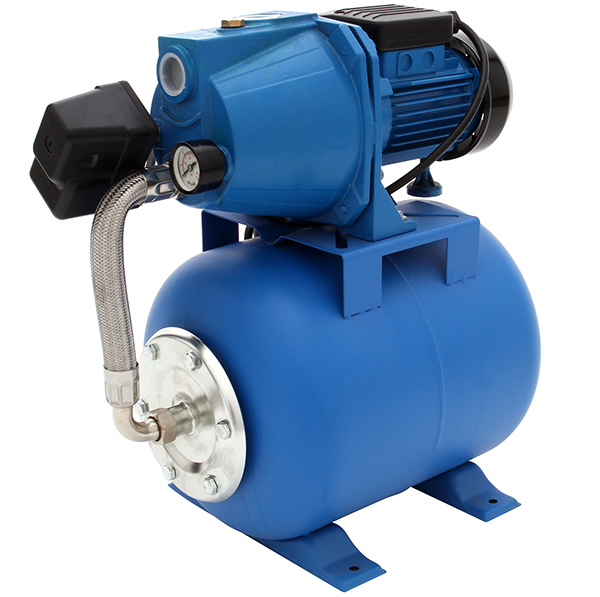
The amount of water that the unit is able to deliver to the water supply system at home per hour is the plant's capacity.
It is indicated in the technical passport attached to the product. The productivity of household appliances for homes and cottages ranges between 2000 - 6000 l / h.
If you do not expect a large consumption of consumed water, then you should pay attention to the mini - installation.

Choosing a pumping station for the house, you should pay attention to the volume of the storage tank. It depends on the amount of water consumed and must provide water supply in the event of a power outage.
The volume of the tank can be from 8 liters to 100 liters.
Protection against dry running and overheating
Units of water supply, having protection from overheating and dry running, are characterized by impeccable work. The system automatically turns off when there is no water in the well, protecting the motor from overheating.
This type of protection extends the life of the pumping station and increases the cost.
Methods of management
- Automatic control method. When the upper and lower limit of pressure is reached, a special relay turns the pump on or off.
- Manual.
- Remote.
Manufacturers of pumping stations
Among the large selection of pumping equipment, Russian consumers are more trusted:

- italian installations Marina, Pedrollo;

- the German brands Karcher, Wilo;

Powerful Italian pumping stations Marina are designed to lift water from a depth of up to 25 m. The cast iron body allows to operate the equipment in any conditions. The automatic mode of operation of the station ensures a constant level of pressure in the water supply system.
The capacity of the unit is 2400 l / h at a power of 1.1 kW suitable for supplying drinking water and watering the site.
Pedrollo is a reliable and efficient equipment. The installation pumps water from a depth of 9 - 30 m. Relatively low power consumption and productivity from 2400 to 9600 l / h, create conditions for the provision of water supply to a private house, cottage, dacha.
Variants of capacities from 24 to 60 liters are calculated for a different amount of water flow. Capacity of the unit is 0.85 - 1.3 kW
German pumping stations from Karcher, this is a quality equipment for the organization of water supply for a country house, cottage or villa. Operation of the installation in the automatic mode does not require additional maintenance. The package includes electrical equipment with reduced power consumption.
Storage tanks with a capacity of 18 - 40 liters are made of steel. The installation with a capacity of 0.95 kW is designed for a capacity of 3800 l / h.
The company Wilo more than a century produces pumping equipment. High quality of products is achieved using advanced technologies. Household pumping stations of this brand are among the most popular among consumers.
It is noted:
- smooth operation;
- reliability;
- ease of use.
The unit is protected against dry running, overheating, condensation. The stations are produced from 0.55 kW to 1.6 kW. You can choose the units with a storage tank from 8 liters to 60 liters. The products are fully manned and ready for use.
Pumping stations Gileks (Russia) are the closest to the conditions of use for the Russian consumer. The device has automatic control, which maintains the necessary pressure in the system.
Various units with capacity from 2700 l / h to 4200 l / h and a power of 0.50 - 1.1 kW are produced for the Russian market. The volume of the storage tank can be from 24 liters to 50 liters.
The body is made of plastic or carbon steel, depending on the model. The pressure in the system is checked according to the pressure gauge provided for this. Jeelex products are reliable and easy to use.
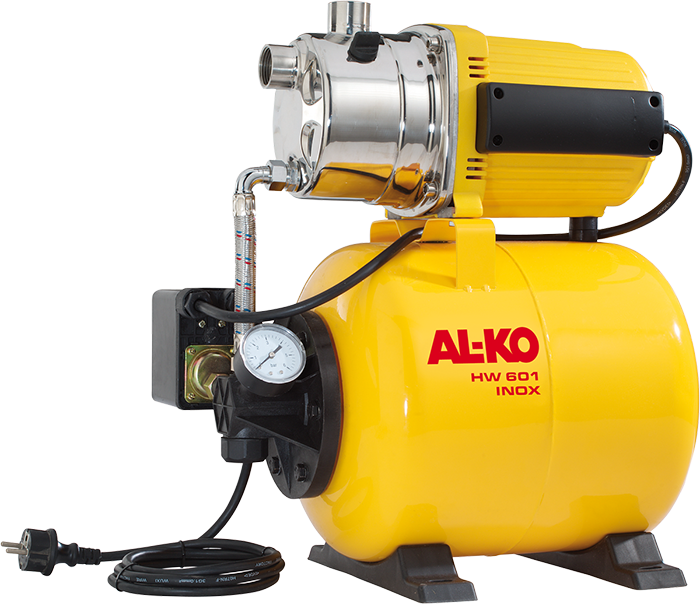
When choosing a pumping station, it is necessary to take into account several important points that will affect the operation of the device:
- Manufacturer. Products manufactured by manufacturers that have proven themselves in the market will not create problems in operation.
- Material of manufacture. Aggregates made with the use of carbon steel have a longer service life than plastic ones.
- Correspondence of technical characteristics to the required parameters. The productivity, the depth of the aquifer, the volume of the storage tank.
- Protection against dry running and overheating. The presence of protection will extend the service life.
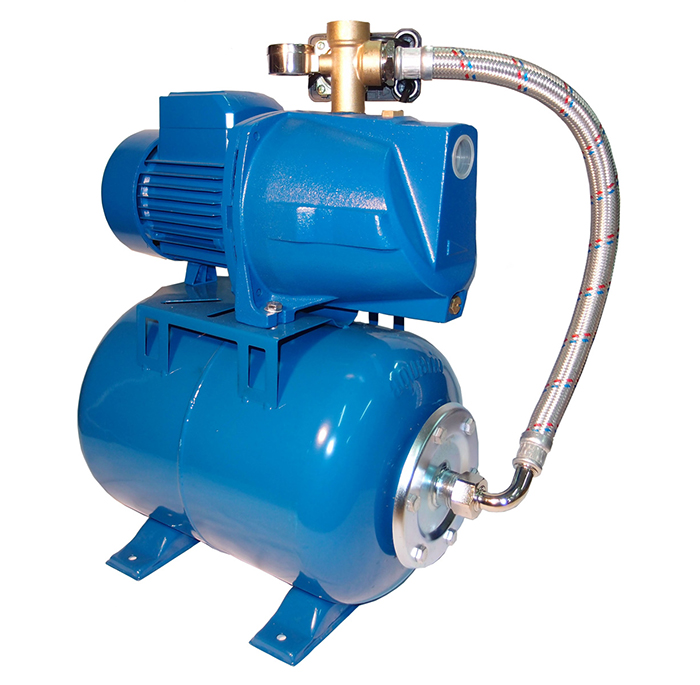
Pumping stations fully feed the water supply system operating autonomously. They not only pump water, but also maintain pressure, creating comfortable conditions for household use.
Of the merits are noted:
- the presence of a system of protection against dry running;
- water in the storage tank;
- use of materials with anti-corrosion properties;
- universal application;
- the assembly is ready for use;
- reduced noise during operation;
- economical energy consumption;
- long service life.
Quality installations do not require additional costs for maintenance and are easy to operate.
Like any technique, pumping stations have drawbacks:
- Limitation on the depth of suction. Most installations are designed for 8 - 9 m.
- Sensitivity to the presence of sand particles and other contaminants. In these cases, a filter is required.
- Commissioning the installation requires filling the hose with water, setting the pressure switch.
- Control over the level of pressure.
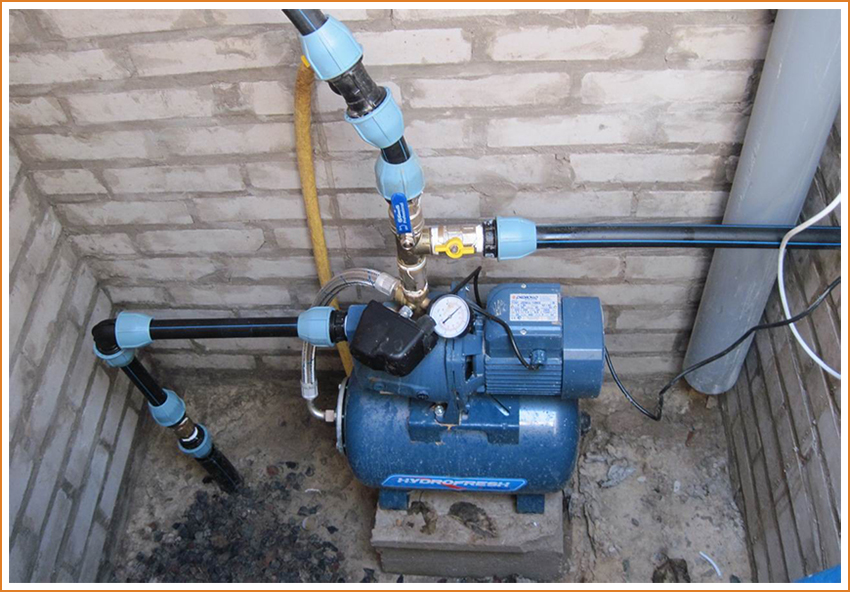
Installation arrives for implementation in full collection and is ready for operation. The consumer needs to connect the unit to the suction pipe and the water supply system. Preliminary it is recommended to install a check valve on the suction pipe to hold water when disconnected from the mains. In the presence of mechanical inclusions the mesh filter is installed.
The unit is recommended to be installed using a damping material to reduce the vibration generated by the pump. The installation must be grounded. Completely connecting the pump station to the water supply system, it is necessary to fill the suction pipe and the pump casing with the water through the filling plug.
After checking the tightness of the connection points, it is necessary to pump the pressure to the level recommended by the manufacturer through a special nozzle. After this, the unit can be connected to the mains.
It should be borne in mind that in winter time the room should be heated. If the equipment is installed in the shaft, then the hatch cover must be double and have a thermal insulation.
- Determine for what purpose is bought. From this will depend on the required power, performance, cost.
- Perform the approximate calculations necessary for comparison with technical characteristics equipment.
- Choose a manufacturer based on the recommendations of experts and customer reviews.
Autonomous water supply in a private house is arranged in the absence of centralized communications, or when it is impossible to connect to them. Pleasure is not cheap. However, if you connect the pumping station yourself, you can save money on installing the equipment a solid amount. For this, it is necessary to select the unit with the optimum characteristics and the installation scheme, and then follow the installation technique.
The pump equipment station performs two functions at once: it delivers water to the house water supply system and automatically maintains the preset pressure in it. This allows you to build a branched network of water pipes and connect to it household appliances - a shower, a boiler, a dishwasher and a washing machine.
The typical design of the station includes:
- Pump;
- Accumulator;
- Automation unit;
- The inlet screen filter is necessary to prevent particles from getting into the system and possible contaminants;
- Pipelines, hoses and necessary fittings.
To prevent the outflow of fluid from the system when the pump stops or the pressure decreases, a non-return valve is installed in the water intake area. A source of water is also needed. For this, a well or well is arranged. It is possible to use a reservoir (pool) with imported water and open reservoirs, if the characteristics of the unit allow pumping contaminated liquid.
Image Gallery



![]()




If the fence is carried out from a natural pond (pond, river, lake), water is used only for household needs and irrigation. If water is extracted from a well or well, analysis is required. According to the results of the study, water belongs to the drinking or economic category.
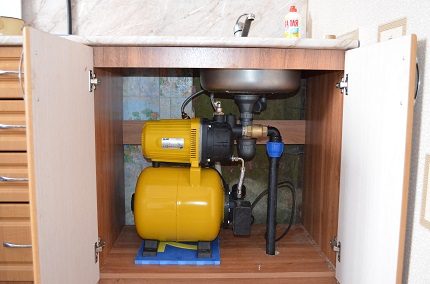
The pumping station is a compact and at the same time functional equipment that provides stable water supply to a private house
Types of pumps used
Ready-made pumping stations are installations with surface pump, which draws liquid from the well due to rarefaction. The ejector can be included in the design of the pump itself, or be remote - in this case it is located in the well. However, when assembling and installing the pump station, a submersible or downhole pump can also be used by hand, especially if it is already available.
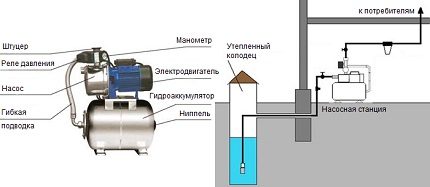
Most often, they use ready-made pumping stations in which all the basic elements are already assembled and adjusted. At installation it is enough to connect a feeding and pressure pipeline
Pumps with internal ejector
Installations with an integrated ejector are capable of lifting water only from a shallow depth - up to 8 m. But they provide a powerful head, exceeding 40 m. They are not afraid of air ingress, so filling the system with water before starting work is not necessary - the station first pumps the air, and then starts to supply water.
They are characterized by good performance and reliability. The disadvantage is the high noise level, which is why they are installed in the house only if there are auxiliary soundproofed rooms.

When installing a station with a surface ejector pump, it is necessary to take into account not only the depth of the water mirror, but also the horizontal section of the supply pipeline
Pumps with external ejector
Stations with remote ejector equip, if necessary, the intake of liquid from a great depth - 20 ... 50 m. In this case, the ejector is lowered into the well (well), as part of the sampling unit. To it lead two hoses from installation - pressure and vacuum (soaking up).
In the first, the liquid is fed into the ejector and forms a vacuum in the suction chamber, the second - lifts up the water from the well. Such units are characterized by low noise level. They do not consume much electricity, but their efficiency reaches only 30-40%.
Submersible or downhole pump
Stations with a submersible (well) pump practically do not produce noise, water can be taken from any depth and with sufficient removal of the well or well from the building. Not afraid of small leaks in the pipeline and air sucking.
However, submersible pumps are quite expensive. They demand clean water - the installation of a powerful filtration system solves the problem, but in this case it will be necessary to clean it regularly. Repair and maintenance are hindered by the need to lift the unit to the surface.

Not suitable for sources with impurities in the water more than 2 g per 1 m3 - the filters quickly clogged and the pump ceases to function
Accumulator - the device and the principle of operation
The starting current of the pump exceeds the working current by 3-5 times and has a destructive effect on its design. Therefore, the life of the pump depends on the number of inclusions. To reduce them in the system, a diaphragm accumulator must be installed.
In the water supply system of the house, it performs the following functions:
- It protects the pump from wear and increases its service life - thanks to the liquid in the membrane compartment, the number of switchings on the unit is significantly reduced;
- Maintains constant pressure in the water supply and protects against pressure drops;
- Eliminates the occurrence of water hammers in the system that are destructive to connected devices and pipeline fittings;
- Provides some water supply in case of power failure.
The device is a sealed vessel, the inner volume of which is divided by an elastic membrane into two containers. One of them is filled with air, and the other is designed for pumping water.

Pressurized air in the hydraulic tank squeezes out water and maintains pressure for a while even in the absence of electricity
The tank works as follows. Water is pumped into the elastic container until the upper pressure threshold is reached. The pump is then switched off. The head in the system is supported by the air layer in the accumulator, the compressed air plays the role of a damper. When the volume of water decreases (consumed by consumers) and the pressure reaches the lower limit, the pump turns on again and fills the tank with water.
Choose the accumulator on the basis of calculations, which take into account the number of residents, the number of water consumption points, the maximum permissible number of inclusions of the pump and its power, the required pressure in the system. Insufficient operating volume of the tank will lead to a permanent pump activation and wear. Capacity with a reserve threatens stagnation of water and a decrease in its quality, a harmful effect on the inner surface of the membrane.
Image Gallery




Control block of pumping station
The standard set of control devices for the pumping station consists of a choke, a pressure switch and a pressure gauge and installed on a pressure pipe. The pressure gauge serves to monitor the current pressure in the system, and the relay is the most important control element of the pumping station. It controls the supply of water to the pressure vessel according to the specified parameters and ensures the automatic operation of the pump, including turning it off.
The main operating elements of the relay are the springs of the minimum and maximum pressure that are triggered when the pressure in the network reaches the set value. At low pressure, the spring is released and the contact closing the pump motor closes. The excess pressure compresses it, and when the maximum threshold is reached, the contact opens. The pump stops and the water supply stops.
The automation unit is a more complex device with more advanced features. In addition to switching electrical circuits in response to an increase and decrease in pressure, the automation unit protects the system from dry running.
Image Gallery
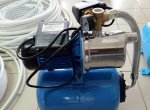

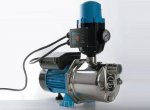

When selecting a control device for stations pumping water from shallow workings, it is better to give preference to the option with protection against dry running. It will protect the pump from overheating and turn it off if, for any reason (dirt got, the liquid level in the source fell below the intake unit), water ceased to flow into the system.

Sensitive elements of the pressure switch are two springs. The larger is adjusted to the minimum pressure, small - to the difference between the minimum and maximum
Principle of operation of water supply installation
The work of the pumping station occurs in cycles, each of which can be divided into two stages:
- The pump turns on and lifts the water from the source. It fills the system and the tank until the pressure exceeds the upper threshold. After this, the pressure switch disconnects the pump motor and the water supply stops. The pump station goes into sleep mode.
- When consumers are switched on (opening of cranes, use of water-consuming equipment), water comes from the accumulator's capacity. The flow of liquid from the tank is carried out until the pressure drops to the lower threshold. This causes a new pump start and water rise.
The number of cycles per hour must not exceed the maximum number of inclusions allowed for the pump in use.
Benefits of using a pumping station
The device of autonomous water supply in your home provides independence and comfort. The pump station offers the following advantages:
- Increases the efficiency of the water supply system.
- Increases the safety of equipment and pipelines.
- Provides some (depending on the capacity of the tank) the water supply and its supply, even when the power supply is cut off.
- Maintains constant pressure and stability of water pressure.
- Increases the durability of appliances and household appliances connected to the water supply system.
- Automatic mode of operation (timely activation and deactivation of the pump unit) reduces equipment wear and energy costs.
- Ability to choose the installation location of the unit.
- Has compact overall dimensions and light weight.
- Easy to mount.
In rural areas, cottage and suburban settlements, water supply communication networks often sin low pressure and unstable head. In this case, the pumping station can be connected to an existing main water pipeline - this will solve the problems with pressure drop and lack of pressure in the water supply.
Where to place the pumping station
When planning the placement of the unit, it should be borne in mind that:
- The location of the pumping station in the immediate vicinity of the water source ensures stable suction and smooth operation of the equipment.
- The installation site must be dry and warm, well ventilated.
- The equipment should not touch the walls.
- It is necessary to provide free access for repair work and preventive inspections.
The installation of a pumping station with a surface pumping unit, especially with an internal ejector, should be carefully thought out, since such a system has a high noise level. There are several mounting options.
In home. The most optimal place for the correct functioning of the station is a heated room. Ideally, if the house has a soundproof boiler room. The last option is the installation of equipment in common rooms (corridor, bathroom, hallway, pantry). But in this case it is located far from the bedrooms and provides sound insulation - for example, make a casing or cabinet.

The best variant of the pumping station device can be considered its installation in a separate room in the house with a borehole drilled directly under the building
In the basement. Quite often a pumping station is equipped in the basement or basement. However, care must be taken to create optimal conditions for the installation of the installation - the room must be sound, heat and waterproof. You can arrange a special box in the subfield, with access to the equipment through the hatch.

A warm and well-equipped cellar with good hydro and sound insulation and ventilation is ideal for installing pumping equipment
In the well. Pumping station is installed on a specially constructed platform in the well. The depth of the installation surface must be such that all equipment is below the freezing level. The well itself is insulated from above. The disadvantage of this scheme is the difficulty in accessing the equipment.

With sufficient width and depth of the well, as well as the pump's power, the station can be installed in a well on a special bracket or platform
In the caisson. Around the well, a sufficient space is set up for subsequent maintenance of the width, buried below the freezing level of the soil. At the surface of the earth, the caisson is closed and insulated, leaving only a small hatch for maintenance. The device of the pit will allow using a pump with an integrated ejector in the case when the depth of the water mirror from the surface of the earth is 9-11 meters.
In a separate (special) structure or an annex. In this case, there will be no noise in the house. However, just to insulate such a room is not enough, it will also require heating. This leads to additional costs for electricity and heating systems.
When installing a station with submersible pump No problems with noise insulation. All elements of the system, except for the pump itself, are installed in any heated building of the house.
Pumping installation technology
Having determined the place of installation of the pump equipment station, they begin to install it.
Preparatory work
Prepare a solid base for the pumping unit - concrete brick or wood, the surface under the installation level. You can use a special metal bracket.
As the pump vibrates quite vigorously during operation, there are backlashes in the connections of the pipeline, leaks appear. To reduce vibration, as well as its destructive effect, rubber pads or a rug are placed under the pump supports, and the installation itself is securely fixed - screw the legs with anchor bolts.
The main condition for the uninterrupted operation of the pump equipment station is the unobstructed flow of liquid from the source. The main problem that must be solved with year-round water supply is the protection from freezing. Therefore, under the pipeline dig a trench - from the foundation to the well or caisson (pit) wells.
The trench must be straight in plan, preferably without turns and bends, so as not to reduce pressure. To exclude the effect of negative temperatures on the pipes, they are buried below the freezing level of the soil in the area. When forming a trench, it is necessary to take into account a slope of 0.03 towards the intake for draining liquid from the pipeline during the conservation period.
With closely located groundwater the water pipe is laid above the critical level, but in this case it is insulated and the heating cable is additionally used. Also, serious thermal insulation and heating will be required if the water pipe is lifted above ground level.

If the pipeline passes through the air, or is not deep, then heating and serious insulation
Assembling the water intake unit
The water intake assembly depends on the type of pump used.
- With a standard connection scheme, a station with a surface pump and an integrated ejector is a check valve connected to a polypropylene pipe through a coupling with a screen filter.
- Installation from external ejector. At the suction of the ejector, a check valve with a screen filter is wound, two pipes are connected from above.
- When using a submersible (downhole) pump, the filter coarse cleaning is included in its construction. Therefore, a non-return valve and a pipe are connected to the unit. The pump has a decent weight, so it is suspended on a solid cable.
Lower the knot to the required depth, considering that minimum distance from it to the bottom of the source is 1 m when using surface pumps and 0.5 m for submersible (well). It should also be borne in mind that the level of the water mirror changes during the year - in the summer it goes down. If the depth of suction is on the edge, then during this period it is possible to lose water supply completely.

Depending on the diameter of the well, the design of the ejector assembly is different. Circulation of water occurs either by two pipes, or by the principle of a pipe in a pipe
Installation of surface elements of the station
In principle, the schemes for installing a pumping station will differ depending on which pumping unit is being used. The basic rule: any additional device is installed through ball Valves with an American and check valves. This will remove the devices for replacement or repair without the need to drain all the water from the system.
It should also be possible to drain the water from the system - for this, a branch is formed in the pipeline by installing a tee to which a drain cock is connected. It is desirable to install a coarse filter on the supply line. On the pressure (in the line leading to the consumers) - a fine filter.
Installation of a surface station-type station is not difficult, since the main elements of the system are already connected to each other. It is a hydraulic accumulator with an electric pump mounted on it and a control unit. In addition to the main fittings, a system is installed in such a system to fill it with water before the first start-up. Similarly drainage system, a tee with a connected ball valve and a funnel is inserted into the pipeline.

When assembling the pipeline, all connections should be sealed with flax, FUM tape or sealing paste to prevent air from entering the system
In other cases, the system elements are mounted independently. When installing a surface station, the pipeline (or two pipelines, if a remote ejector is used) from the well is connected to the pump.
Next, the hydraulic accumulator and the control unit are installed. For a station with downhole pump it will be all the basic surface elements in the circuit. The most convenient way to do this is to use a 5-outlet choke, which is mounted in a pressure pipe in a convenient location. A pressure switch and a manometer are screwed into it.
A hydraulic accumulator is connected to the side inlet of the union. For the convenience of maintenance, it is connected through a ball valve with an American and arrange a discharge.
Conduct consumers' connection to the pumping station. Most often the first element is the distributing collector of cold water.
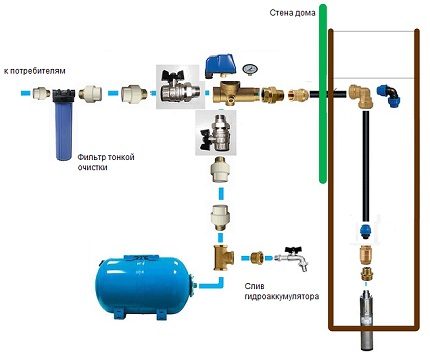
Such a system is less sensitive to air entrapment, but all joints must be tight
Launching the station of pumping equipment
The electric motor of the pump has a high power, so it is better to provide the pump equipment station with its own power line, arrange a grounding and install a voltage regulator.
Check the pressure of the air bag of the accumulator. It must be 10% less than the pump start pressure. However, this setting is done in the operating mode. Preliminarily, it is necessary to achieve the following values: for a tank with a capacity of 20-30 liters - 1.4 ... 1.7 bar, a capacity of 50-100 liters - 1.7 ... 1.9 bar.
Before the first start of the installation with a surface pump, the working part of the system is filled with water. To do this, unscrew the plug from the filler hole located at the top of the pump. If there is a filling hopper in the pipeline, it is better to use it. Fill the liquid until completely filled until it begins to pour out. Then the hole (valve) is tightly closed.

When the system is filled with liquid through the filling hole of the pump, it is convenient to use a conventional funnel
Startup sequence:
- The pump is connected to the mains.
- The valve of the fill funnel of the pipeline with the surface pump is slightly opened to remove any remaining air that has entered the system.
- Turn on the unit - within 2-3 minutes from the outlet of the pressure pipe (or open faucet water) should flow water.
- If the liquid does not flow, pumping equipment is turned off, water is added to the system and switched on again.
After a successful start-up, the equipment should be "run-in" and, if necessary, adjust the settings of the hydraulic unit and the pressure switch.
Operation of the pump equipment station
After the pumping station is put into operation, it is periodically serviced. It is necessary to clean the coarse filter in time. Without this, the capacity of the plant is gradually reduced, the water is jerking, and the fully clogged filter will lead to a "dry" operation and shutdown of the system. The frequency of purification depends on the content of impurities in the pumped water.
Once a month, or after prolonged downtime, winter conservation or repair work, check the pressure in the air compartment of the accumulator. If necessary, the air is pumped up. When using the station only in the summer, it is necessary to drain all water before the frost.
Video compilation on the topic
The basic rules for connecting a pumping station of surface type:
Maintenance and adjustment of surface-type pumping station:
How to make a pump station based on a submersible pump:
Proper installation of the pumping station provides a private house water supply with parameters that are not inferior to a city apartment - constant pressure and sufficient pressure. For the system to work as efficiently as possible, before choosing and installing the equipment, you should consult a specialist and carry out an estimated calculation.
Staying outside the city, in the country residence, has additional difficulties, since not everywhere there are centralized communications. The inhabitants of the periphery improve the living conditions in the cottage or house so that it does not differ from the urban comfortable housing. One of the points of comfortable life concerns the constant availability of water in sufficient quantity. In this case, special equipment will help - the pump station with their own hands. Due to the self-installation you can save your family budget.
The device and the principle of operation of the unit
The main number of wells in country plots has a depth of up to 20 m - optimal for the installation of automatic equipment. With these parameters, you do not need to purchase borehole pump, an automatic control system or intermediate capacity: water directly from the well (or well) to the points of analysis. To ensure the correct connection of the pumping station, it is necessary to understand what it consists of and how it works.
The main functional nodes of the station are the following equipment:
- A centrifugal pump providing water lifting and transporting it to the house.
- Hydraulic accumulator, softening hydraulic shock. It consists of two parts separated by a membrane.
- An electric motor connected to a pressure switch and a pump.
- A pressure switch that controls its level in the system. If the pressure drops below a certain parameter - it starts the motor, if there is an over-pressure - turns it off.
- A manometer is a device for determining the pressure. With its help produce adjustment.
- A water intake system equipped with a non-return valve (located in a well or well).
- The main line connecting the water intake and the pump.

With the help of this formula it is possible to determine the maximum suction depth: the diagram demonstrates clearly what measurements need to be done for this

The most common version of the pump station is a hydraulic accumulator with a surface pump mounted on top and a unit including a pressure gauge, a pressure switch and a dry running protection

As can be seen from the table, the cost of pumping stations can be different. It depends on power, maximum head, throughput, manufacturer
Before installing the pumping equipment, it is necessary to purchase all the functional parts according to the parameters of the well and the water supply system.
Self-assembly of the pumping station
At first glance, there are a lot of places for mounting equipment - this is any free corner in the house or outside it. In fact, everything turns out differently. However, only a well-thought-out installation of the pumping station guarantees its full operation, therefore it is necessary to observe certain conditions.
Mounting conditions:
- proximity to the well or well provides stable water absorption;
- the room must be warm, dry and ventilated;
- placement should not be close, as preventive and repair work is required;
- the room should hide the noise that the pumping equipment issues.

One of the options for installing a pumping station is on a shelf specially attached to the wall. The room for installation is a boiler room, boiler room or utility room
It is difficult to comply with all conditions, but it is desirable to adhere to at least some. So, consider a few suitable places for installation.
Option # 1 - room inside the house
A well-insulated boiler house on the territory of the cottage is an ideal area for installation in case of permanent residence. The main disadvantage is a good audibility with poor-quality room noise insulation.

If the pumping station is located in a separate dacha house, the well is best placed directly under the building
Option # 2 - basement
A basement or a basement can be equipped for the installation of a pumping station, but this should be considered when designing. If the room is not heated, and the floors and walls are not isolated, you will have to spend a lot of effort to prepare it.

A well-equipped basement is excellent for mounting a pumping station. During the laying of the pipeline in the foundation of the house, make a hole for the communications
Option # 3 - special well
Possible option, having a couple of pitfalls. The first is the difficulty in maintaining the required level of pressure in the house, the second is the difficulty of performing repair work.
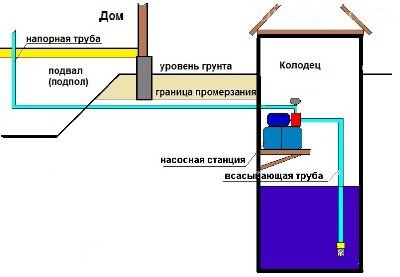
When the pump station is located in a well, on a specially equipped site, the pressure level should be adjusted, which depends on the equipment's capacity and pressure pipe parameters
Option # 4 - caisson
A special platform near the well exit is also suitable for installation, the main thing is to correctly calculate the depth of its location. The necessary temperature will create the heat of the earth.

The pump station, located in the caisson of the well, has two advantages: complete noise isolation and frost protection during frosts
In the absence of specially designated places, the unit is installed in common areas (in the hallway, bathroom, corridor, in the kitchen), but this is an extreme option. The loud noise of the station and comfortable rest are incompatible concepts, therefore it is better to prepare a separate room for installation in the dacha.
Pipeline laying
Well, as a rule, is located near the house. In order for the pumping station to function properly and without interruptions, it is necessary to ensure unhindered flow of water from the source to equipment that is located in a specially designated place. For this purpose, a pipeline is laid.
Low winter temperatures can lead to the freezing of pipes, so they are buried in the ground, preferably to a depth that is below the freezing level of the soil. Otherwise, the line must be insulated. The works are as follows:
- trench digging with a slight bias towards the well;
- device in the foundation of the hole for the pipe at the optimum height (if necessary);
- pipe laying;
- connection of the pipeline to the pumping equipment.
During the arrangement of the highway, one can face such a problem as the presence of high-standing surface waters. Pipes in this case are mounted above the critical level, and for thermal protection use a heat-insulating material or a heating cable.

Benefits polyethylene pipes and fittings in front of metal analogs: no corrosion, easy installation and repair, low price (30-40 rubles per meter)
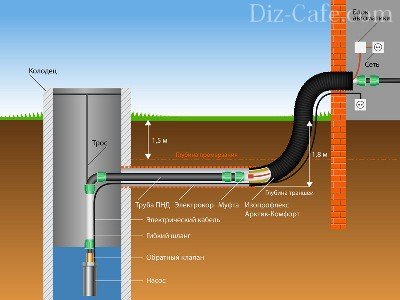
This scheme of installation of the pumping station shows a version of the insulation of pipes above the freezing level of the ground
![]()
The optimal option for the thermal insulation of external water pipes is a hard "shell" made of expanded polystyrene (thickness - 8 cm), wrapped in foil
For thermal insulation of pipes that are laid above the freezing level of soil, often use inexpensive and environmentally friendly material - mineral wool on a basalt basis.
External work
From the outside polypropylene pipes fix a metal mesh, which will serve as a filter for rough cleaning. In addition, a check valve is needed to ensure a stable filling of the pipe with water.
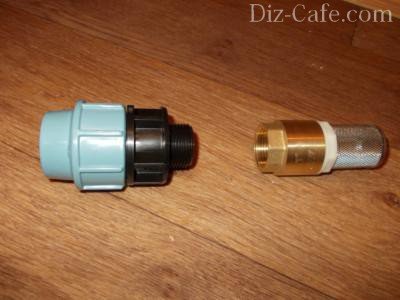
It is possible to purchase a ready-made hose with a check valve and a coarse filter, but equipped with their own hands will be much cheaper
Without this part, the pipe will remain empty, therefore, the pump can not pump water. The non-return valve is fixed by means of a coupling with external thread. The end of the pipe equipped in this way is placed in the well.

The coarse filter for the supply hose is a metal mesh with a shallow cell. Without it, the correct operation of the pumping station is impossible
After performing these actions, it is possible to engage in upgrading the well head.
Connecting equipment
So, how to properly connect the home pumping station, in order to avoid further technical inconsistencies? First of all, install the unit on a specially prepared base. It can be brick, concrete or wooden. To ensure stability, screw the legs of the station with the help of anchor bolts.

For the installation of the pumping station, special pedestal legs are provided, however, in order to provide additional stability, the equipment must be fixed with bolts
If you place a rubber mat under the equipment, you can extinguish unnecessary vibrations.

For more convenient maintenance, the pumping station is installed on a base height with a regular table made of a durable material - concrete, brick
The next step is to connect the pipe from the well. Most often this polyethylene product with a diameter of 32 mm. For connection, a male thread (1 inch), a 1-inch male corner, a non-return valve with a similar diameter, and a direct American tap are required. We connect all the details: fix the pipe with a clutch, fix the "American" with thread.

One of check valves is located in the well, the second is mounted directly to the pumping station. Both valves serve to protect the system from water hammers and ensure the correct direction of water movement
The second output is for communication with water supply network. Usually it is located at the top of the equipment. The connection pipes are also made of polyethylene, as this is an inexpensive, ductile, durable material. Fixing occurs in a similar way - with the help of an "American" and a combined sleeve (1 inch, 90 ° angle) with external thread. First, the "American" is screwed to the exit of the station, then in the crane we mount the coupling from propylene, finally water pipe we fix in the coupling by the soldering method.

To fully seal the connections, they must be sealed. Traditionally, a winding made of flax is used, a special sealing paste
After you have connected the pumping station to the water intake and water supply system, it is necessary to check the quality of its operation.
We carry out a trial run
Before starting the station, it must be filled with water. Through the filling hole let the water so that it filled the hydraulic accumulator, trunk lines and pump. Open the valves and turn on the power supply. The engine starts and the water starts to fill the pressure pipe until all the air has gone off. The pressure will rise until the set point is reached - 1.5-3 atm, then the equipment automatically turns off.

In some cases, it is necessary to adjust the pressure value. To this end, remove the cover from the relay and twist the nut
As you can see, it is quite easy to make installation of a home pumping station with your own hands, the main thing is to follow the installation instructions.



